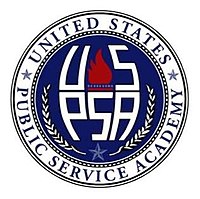TheUnited States Public Service Academy(S. 960 and H.R. 1671) is a proposed institution ofhigher education.The Academy would be a federally subsidized four-year college modeled on theUnited States military service academiesdevoted topublic service. It was envisioned in 2006 and introduced into congress in 2007 and again in the next congress but did not pass.

The proposed academy
editAcademics
edit- Applicants to the Academy would follow a congressional nomination process similar to that used for admission to the US service academies.
- Once admitted, students would earn credits toward aBachelor of ArtsorBachelor of Sciencedegree. Students would be required to choose a public service concentration in the field in which they ultimately will serve post-graduation.
- All USPSA students would be required to spend a period of timestudying abroad.Students would be required to take courses inforeign languagesandinternational relations.Students would spend eight weeks each summer participating in structured learning programs, such asemergency responsetraining, civilian internship in thearmed forces,and an internship with a public agency.
Service requirements
edit- Graduates would be required to serve the United States for five years in thepublic sector.
- Failure to complete five years of service would result in a dishonorable discharge from the Academy. Delinquent graduates would be required to repay the cost of their education.
- The Academy would subsidize its students’ graduate education in return for an extended service commitment. For every year of subsidized graduate education, students must add two additional years to their service commitment.[1]
Legislative history
editThe Academy was envisioned in 2006 byChris Myers AschandShawn Raymond.
The Public Service Academy Act was first introduced in March 2007 byHillary ClintonandArlen Specterin the Senate andJames MoranandChristopher Shaysin the House of Representatives. In the 110th Congress, the bill had 24 Senate co-sponsors and 123 House co-sponsors.
The bill was reintroduced unsuccessfully in the111th Congressas House Bill 2102. The Senate leads included Arlen Specter andMark Udall.
Criticism
editCriticism of the Academy has focused mainly on the flexibility and cost-effectiveness of the model.Maxwell SchoolprofessorsDavid Van SlykeandAlasdair Robertswrote that the proposed academy would be redundant to the missions of the 150 undergraduate and graduatepublic affairsprograms already in existence, whose breadth and diversity could never be matched by a single institution.[2][3]They contend that a nationwide tuition reimbursement program resemblingROTCwould be better suited to the training of young civil servants.
References
edit- ^Deparle, Jason (2009-01-07)."A Plan to Turn the Lowly Bureaucrat Into a Cherished Public Servant".The New York Times.Retrieved2010-05-27.
- ^David Van Slyke andAlasdair Roberts."Good Intentions, Bad Idea".Archived fromthe originalon 2008-07-20.Retrieved2008-05-11.
- ^David Van Slyke and Alasdair Roberts, A Poorly Designed Solution for a Misdiagnosed Problem,Administration & Society41 (March 2009: 127-129.